Gathering of Eagles 2011
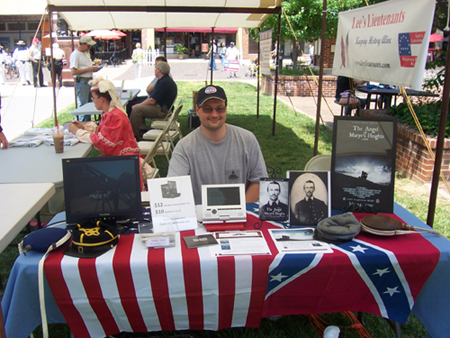
On Saturday (June 4th) I had the privilege of participating in the Annual Gathering of Eagles at the historic Old Courthouse Civil War Museum in Winchester Virginia. This one-of-a-kind event offers a weekend filled with the foremost impressionists of leaders and politicians from both sides of the Civil War. This was my fourth appearance in six years and although the crowds were a bit slimmer due to the economy, everyone had a great time.Coinciding with the Civil War Sesquicentennial, this year’s theme was 1861, the “Gathering Storm.” The hosts, Lee’s Lieutenants and the Federal General’s Corps, delivered incredibly unique performances that focused on the period leading up to the war. It was neat to see all of the Confederate Generals dressed up in their blue U.S. Army uniforms when performing the scenes that took place prior to secession. Some of the performances included a re-enactment of the two president’s inaugural addresses, an emotional piece that dealt with the separation of friends, a discussion over the issues of loyalty and traitors, and the always popular “Meet the Generals.”
I had the privilege of sharing the Author’s Tent with some outstanding historians including Jerry Hilsworth, author of Civil War Winchester and Scott Mingus Sr. (and his son) author of Flames Beyond Gettysburg and about 6 other titles. I really enjoyed the opportunity to get to know these guys who are all experts in their field of study. Jerry’s knowledge of Winchester’s wartime experiences, especially off of the battlefield, was tremendous and Scott’s expertise on regiments like the Louisiana Tigers blew me away. Scott’s son, a professor from Liberty University, and I shared some great conversations on the state of Major League Baseball.
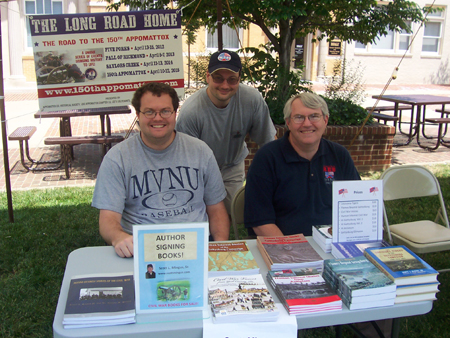
This year I focused on selling DVDs in place of my books. Despite being an outdoor event, I managed to run electricity and set up our usual display with movie props, promo materials, a behind the scenes kiosk, and the film playing on a small screen. This enabled me to share the story of Richard Kirkland with a diverse group of people who were coming in and out of the re-enactor events. I spoke to several college kids, members from a kid’s soccer team, retired folks, Civil War buffs and an elementary school librarian. My parents even came by on the way home from Gettysburg.Everyone was very receptive to Kirkland’s story and asked great questions. The one comment I got repeatedly was that folks were familiar with the monument in Fredericksburg, but never knew the story behind it. Every time I hear that it reinforces how important this story is and how thankful I am to be part of this movie. One of the biggest joys for me as the producer is the opportunities that I get to meet people. Over the last year we have screened the The Angel of Marye’s Heights in Fredericksburg, Spotsylvania, Stafford, Lexington, Lynchburg, Pittsburgh, Manassas, Winchester, Arlington, Savannah, Columbia and Brunswick. The Angel is also being shown (and sold) at multiple museums and used in history classrooms from New York to California. People from almost every state have purchased a copy of the DVD and we even have some international sales. The buzz keeps growing and growing.
This past weekend was the cap on a year that has reinforced the idea (for me) that doing this stuff really matters. Whether it’s writing a book, attending a re-enactment, producing a documentary, or simply talking to people, those of us that have dedicated a portion of our lives to preserving and presenting the history of our nation are doing a great service to the memories of those who came before us. This is proven by the people we meet, who validate our efforts and make all of this worth it.
The search for Adam Allan continues
As a historian and writer I feel very fortunate to be living in the Internet Age. Network computers have been a constant in my life since the 6th-grade and thanks to the rapid progression of web-technology, the once laborious process of reference-gathering has been replaced (or at least augmented) by nanosecond cyber-surfing. Routine functions like electronic archiving and keyword searches have enabled the Internet to evolve into a vast repository of historical information. Although a discerning eye and traditional researching skills are still required, the ability to quickly identify potential sources and whittle them down has been accelerated greatly. To be completely honest, I do not know if I would have ever pursued a historical writing vocation if I had to do it the slow way, you know…by hand. Actually check that - there is no way.
The ability to blog and participate in social networks such as Facebook has provided an entirely new way of meeting people. You may recall a few months back that I began a side-project searching for information on a Fredericksburg Loyalist named Adam Allan (See March 15, 2011 posts: Looking at Loyalists – and – A History Mystery). On day-one I came upon two “Adam Allans” who shared many similarities including their name. This required me to expand my study and pursue both individuals separately. This week I borrowed a few library books published by local Colonial-era historian Paula S. Felder. I am still reading them. After 2+ months I have yet to track down a definitive connection that proves these Allans are one and the same or different people.
Yesterday I received an email from a wonderful woman named Cathy in Brisbane Australia. Cathy is a direct descendant of Adam Allan’s brother John. She discovered my blog while searching the Internet and decided to contact me directly. I am grateful she did. Not only did Cathy affirm some of my own suspicions, she was kind enough to send me the family background that she had acquired along with permission to post it here. This is a perfect example of how the Internet can bring people together who otherwise would never have met. Thanks to Cathy I now have a better sense of who I am looking for. I will be sending her my conclusions when the time comes and look forward to sharing this journey with her family. Here are her findings:
I can confirm for you that the Adam Allan, who was a lieutenant in the Queen's Rangers, was christened in Dumfries, Scotland, on 4 March 1756. I have attached our copy of his christening entry (an image which is obviously subject to copyright). Adam is the first entry on the page. He was the third son of James Allan, a Dumfries shoemaker, and his wife, Margaret Black. "Shoemaker" when applied to James Allan definitely does not appear to have meant "impoverished cobbler eking out a living". All the evidence we have found so far suggests that the Allans were very comfortably placed and that Adam was a well educated young man. In addition to their shoemaking interests, the family had a farm, Fountainbleau, on the outskirts of Dumfries; a property which they continued to own well into the nineteenth century.
There is absolutely no doubt that our Adam Allan is the man who was a lieutenant in the Queen's Rangers. Adam appears to have had a bit of an artistic bent as he translated Allan Ramsey's "The Gentle Shepherd", a play that had been written in the lowland Scots vernacular, into English. He had this translation published in London in 1798 with the following title page:
THE NEW GENTLE SHEPHERD
A Pastoral Comedy
Originally Written in the Scotch Dialect by Allan Ramsey Reduced to English by Lieutenant Adam Allan
In the late 1880s, William Allan, a grandson of Adam's brother John, loaned a copy of this translation, together with a silhouette of Adam Allan, to the Dumfriesshire and Galloway Scientific, Natural History and Antiquarian Society for display purposes. These items were obviously prized family possessions. I've attached our copy of the Transactions of that Society that record the loan and note the author of the work as Lieutenant Allan of the Canadian Queen's Rangers.
As to whether Adam Allan of the Queen's Rangers and the Adam Allan in Williamsburg and Fredericksburg are the same man: When left to his own devices, our Adam spelt his surname Allan (as did all the family) just as it appears in the advertisements you uncovered. The only place I have seen it recorded as Allen is in his military records. Our Adam would have been barely 20 years old when the events in Fredericksburg took place. Twenty just seems so desperately young both to be running a stocking manufacturing business and to be being tarred and feathered for your political convictions. But maybe that's just me looking at an 18th century event through 21st century eyes.
Remembering where it all began...
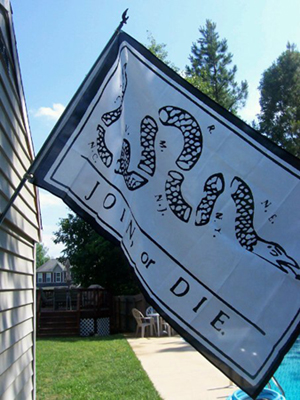
This is how we acknowledge Memorial Day at the Aubrecht house.
The “Join, or Die.” flag is based on a well-known political cartoon that was created by Benjamin Franklin and first published in his Pennsylvania Gazette on May 9, 1754. The image appeared alongside an editorial about the disunited state of the colonies, and helped make his point about the importance of colonial unity. The powerful depiction of a segmented snake resonated with his readers who adopted it as a symbol of colonial freedom during the American Revolutionary War.
Franklin was well aware of the courage and sacrifice that would be required to prevent his visual metaphor from becoming a reality. In a letter written to his friend Jonathan Shipley in 1782 he wrote, “After much occasion to consider the folly and mischiefs of a state of warfare, and the little or no advantage obtained even by those nations who have conducted it with the most success, I have been apt to think that there has never been, nor ever will be, any such thing as a good war, or a bad peace.”
A few announcements before I go off the grid for Memorial Day weekend...
I spoke with my friend Benjamin Smith at Patriots of the American Revolution. Due to a high volume of articles my feature on the Alexander Hamilton – Aaron Burr duel titled “American Gladiators” has been pushed from the July/August issue to the September/October mag. Ben also approved my pitch for a feature on Thomas Paine titled “Beliefs of an Unbeliever.” This piece will look at his highly controversial pamphlet The Age of Reason; Being an Investigation of True and Fabulous Theology.
After a 2-year hiatus, I am returning to the Gathering of Eagles at the Winchester Court House Civil War Museum on Saturday, June 4th. This will be my fourth appearance at this unique re-enactment hosted by Lee’s Lieutenants. I will be set up in the author’s area, selling copies of “The Angel of Marye’s Heights” on DVD, as well as Will White’s soundtrack on CD. Hope to see you there.
There are some BIG announcements coming up from Right Stripe Media. Good things continue to happen with our first documentary The Angel of Marye’s Heights and we are deep into the planning stages for our second film project on Billy The Kid (working title: “El Chivato”) Details to come. My partner Clint Ross and I have been approached by a school teacher from Ditmas Junior High School in New York who is in the process of gathering materials to teach young children about the Civil War. We have agreed to provide a free copy of our DVD along with some personalized letters for the class. This means that “The Angel” is now being shown at the elementary, middle school and college level. On a slightly related topic, I hope to have the video from my speech in Pittsburgh on the 123rd PA Volunteers posted in a week or two.
Homosexuality in Colonial America: How far have we come?
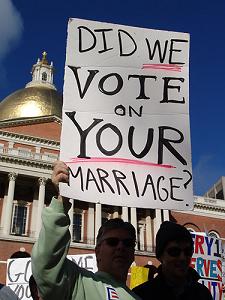 In keeping with our current events theme…
In keeping with our current events theme…
This past week witnessed a resurgence of debate over the issue of gay marriage. These discussions have reignited the controversy surrounding the Federal Marriage Amendment (FMA), a proposed addition to the United States Constitution which would limit marriage in the United States to unions of one man and one woman. This proposal also prevents the judicial extension of marriage rights and medical benefits to same-sex couples. After failing to pass the FMA at a national level in 2006, proponents shifted their focus to limiting the rights of homosexuals at the state level.
Five years later the debate rages on and it is impossible not to compare the current plight of the gay community to previous trials of suffrage and segregation. Whereas prejudice once ruled over race and gender, it now presides over sexual preference. History therefore shows us that it is only a matter of time before the civil rights of homosexuals will be recognized as being equal to their heterosexual neighbors. Until then, America will continue its longstanding hypocrisy of preaching freedom for all, while simultaneously depriving it from a portion of its own citizens.
Often times those engaged in these pseudo-moralistic debates attempt to gain the upper hand by calling on the wisdom of the Founding Fathers. This is done in a vain attempt to bolster their side of the argument while bringing confidence to their cause. More often than not, the revealing nature of the Founder’s views prevents either side from claiming their endorsement. Adding to this folly is the vast misconception that the Founders were somehow our contemporaries and would share our same perceptions. The reality is that they lived in a very different world and any attempt to draw a parallel between them (then) and us (now) is completely illogical.
One of the more difficult revelations to accept when examining the Founding Fathers is that they were wrong. As brilliant and admirable as these men were, they were mere mortals, capable of making mistakes, or worse, perpetrating ignorance. Among their character flaws were chauvinism, bigotry and prejudice. These of course were standard principles for the period, but nevertheless they are to be condemned. It is only when we acknowledge the Founder’s primitive views on women and minorities that we can truly see how far we have come. And although the same cannot yet be said for the gay community, they have also traversed a remarkable distance from where we started as a nation. Believe it or not there was a time in American history when homosexuality was recognized as a capital crime, punishable by death.
In 1976 Louis Compton, a faculty member at the University of Nebraska published a study titled “Homosexuals and the Death Penalty in Colonial America.” (Read PDF here) The abstract of this paper states that the article traces the legislative history of statutes prescribing the death penalty for sodomy in 17th-century New England and in the other American colonies. His introduction follows:
As the nation prepares to celebrate the bicentennial of the Declaration of Independence, the question of the status of the homosexual in pre-Revolutionary America comes to mind. The Body of Liberties approved by the Colony of Massachusetts Bay in 1641 welcomed refugees seeking to escape “the Tiranny or oppression of their persecutors” or famines or wars. For several hundred years America was to serve as a haven for minorities threatened with religious or political persecution in other lands. What then did it offer the homosexual? Not, assuredly, liberty or the pursuit of happiness. Indeed, it appears that in 1776 male homosexuals in the original 13 colonies were universally subject to the death penalty, and that in earlier times, for a brief period in one colony, lesbians had been liable to the same punishment for relations with other women. The following essay is an attempt to trace the capital laws against homosexuals in these colonies from their origin in the first settlements until their abolition after the Revolution.
The first official statute against homosexuality cited by Compton was passed by British Parliament in 1533 under King Henry VIII. This law made it a capital felony for anyone to “commit the detestable and abominable vice of buggery with mankind…” Although the act was repealed and re-enacted on multiple occasions, it was later reinstated by Queen Elizabeth in 1563 and remained relatively unchanged until 1861. Only then was the mandatory death penalty dropped in favor of life imprisonment. English Continental law, following the biblically influenced canon-law also included lesbian-acts in its list of offenses. As the British Empire spread across the Atlantic Ocean to the American colonies, five of the pre-revolutionary settlements in the south adopted variations of the English law. Northern colonies however developed their own Puritan-influenced version which eventually led the way for America’s unique legal-style.
In 1641, the Bay Colony adopted a new “Body of Laws and Liberties” which included 12 capital crimes to include sodomy. The inclusion of the Old Testament language contained in the Book of Leviticus (20:13) reveals the 2,000+ year of influence that permeated this statute. The verse states: “If any man lyeth with mankinde as he lyeth with a woman, both of them have committed abhomination, they both shall surely be put to death.” Known for their religious superstitions the Puritans felt that their claims in the New World could be taken by God if they failed to uphold their biblical principles and left “sexual criminals” unpunished. These anti-deviate laws remained in one form or another and continued to spread in unison with the colonies expansion. (Surprisingly England and France eventually lifted all references to illegal sodomy in 1791 in the wake of the Declaration of the Rights of Man, which had maintained that “liberty consists in the power to do anything that does not injure others” and that “the law has the right to forbid only such actions as are injurious to society.”)
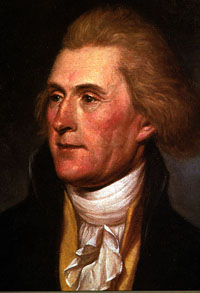 Fast forward to 1779 when Virginia Governor Thomas Jefferson established a committee tasked with reforming VA’s criminal codes. While presenting his manuscript titled “Bill Proportioning Crimes and Punishments” Jefferson explained that a number of existing penalties would be excluded under the Bill of Rights which forbid cruel and unusual punishments. This antiquated concept of proportional punishments mimicked an ‘eye-for-an-eye’ in which poisoners were poisoned, maimers maimed, and sodomites castrated. On June 18, 1779 Jefferson’s committee put forth a bill that stated “whosoever shall be guilty of Rape, Polygamy, or Sodomy, with man or woman, shall be punished, if a man, with castration, if a woman, by cutting thro' the cartilage of her nose a hole of one half inch diameter at the least.” The Virginia legislation never adopted Jefferson’s bill and when a revised code was released in 1792, sodomy was once again identified as a capital offense punishable by death.
Fast forward to 1779 when Virginia Governor Thomas Jefferson established a committee tasked with reforming VA’s criminal codes. While presenting his manuscript titled “Bill Proportioning Crimes and Punishments” Jefferson explained that a number of existing penalties would be excluded under the Bill of Rights which forbid cruel and unusual punishments. This antiquated concept of proportional punishments mimicked an ‘eye-for-an-eye’ in which poisoners were poisoned, maimers maimed, and sodomites castrated. On June 18, 1779 Jefferson’s committee put forth a bill that stated “whosoever shall be guilty of Rape, Polygamy, or Sodomy, with man or woman, shall be punished, if a man, with castration, if a woman, by cutting thro' the cartilage of her nose a hole of one half inch diameter at the least.” The Virginia legislation never adopted Jefferson’s bill and when a revised code was released in 1792, sodomy was once again identified as a capital offense punishable by death.
Individual states began repealing similar rulings at a state level and in 1873, (12 years after England had dropped it) South Carolina became the last and final state in America to eliminate the death penalty in favor of an up-to 5-year prison sentence for homosexual acts. This proclamation ended two centuries of capital punishment for having same sex relations in the United States. There are two incidents of executions included in Compton’s paper. The first was the case of a gay Virginian named William Cornish who was caught having sexual relations with a man, sentenced, and killed in 1625. (No data exists on his partner.)The second was the hanging of another homosexual named William Plain at Guilford in 1646. Both of these citizens paid dearly for their taboo lifestyles. Fortunately as the nation progressed so did their perceptions of crime and punishment. Still this evolving mindset did nothing for the day-to-day lives of homosexuals who were forced to live in secret. Compton’s own retrospective summarizes the plight of the gay community in colonial times:
America's capital laws must have created a psychological reign of terror for the homosexual in the 17th and 18th centuries. Discrimination could be justified by pointing to the death penalty as a sign of the intensity of society's disapprobation. Presumably, few homosexuals emigrated to America with Puritan settlers. But there is no reason to suppose that America's first colonists had fewer homosexual sons and daughters than any other group. For these young people, “growing up gay” in the land of the free must have been a brutalizing experience.
Recognizing our nation’s penchant for righting wrongs, it’s hard to believe that government-endorsed ‘homophobia’ continues to exist in the 21st-century. Whereas we once looked down upon our fellow citizens for their gender or skin color, we wouldn’t think of condoning the practice of sexism or racism today. Unfortunately we cannot say the same for our homosexual neighbors who continue to demand representation. Only time will tell if same-sex marriage is the next milestone in the progression of American culture. Our collective history has shown that equality can be accomplished through tolerance. Despite our differences over lifestyles and beliefs we must live up to the principals of freedom put forth by our Founding Fathers, even if they didn't. Only then can we honestly claim to live in a country that offers liberty, and justice for all.









 In keeping with our current events theme…
In keeping with our current events theme…  Fast forward to 1779 when Virginia Governor Thomas Jefferson established a committee tasked with reforming VA’s criminal codes. While presenting his manuscript titled “Bill Proportioning Crimes and Punishments” Jefferson explained that a number of existing penalties would be excluded under the Bill of Rights which forbid cruel and unusual punishments. This antiquated concept of proportional punishments mimicked an ‘eye-for-an-eye’ in which poisoners were poisoned, maimers maimed, and sodomites castrated. On June 18, 1779 Jefferson’s committee put forth a bill that stated “whosoever shall be guilty of Rape, Polygamy, or Sodomy, with man or woman, shall be punished, if a man, with castration, if a woman, by cutting thro' the cartilage of her nose a hole of one half inch diameter at the least.” The Virginia legislation never adopted Jefferson’s bill and when a revised code was released in 1792, sodomy was once again identified as a capital offense punishable by death.
Fast forward to 1779 when Virginia Governor Thomas Jefferson established a committee tasked with reforming VA’s criminal codes. While presenting his manuscript titled “Bill Proportioning Crimes and Punishments” Jefferson explained that a number of existing penalties would be excluded under the Bill of Rights which forbid cruel and unusual punishments. This antiquated concept of proportional punishments mimicked an ‘eye-for-an-eye’ in which poisoners were poisoned, maimers maimed, and sodomites castrated. On June 18, 1779 Jefferson’s committee put forth a bill that stated “whosoever shall be guilty of Rape, Polygamy, or Sodomy, with man or woman, shall be punished, if a man, with castration, if a woman, by cutting thro' the cartilage of her nose a hole of one half inch diameter at the least.” The Virginia legislation never adopted Jefferson’s bill and when a revised code was released in 1792, sodomy was once again identified as a capital offense punishable by death.